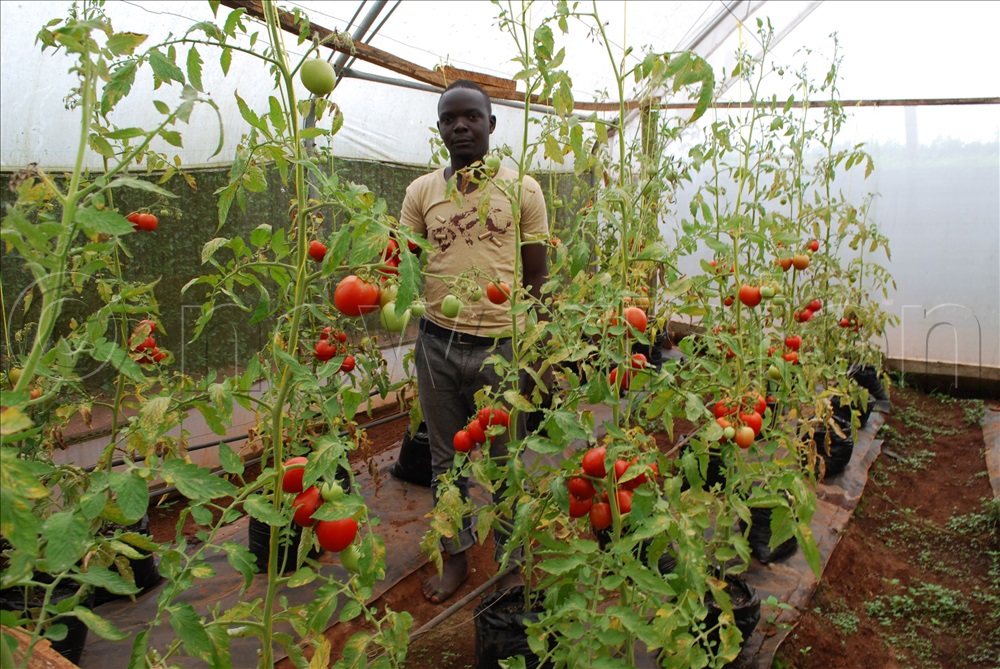By Umar Nsubuga
Because of unpredictable weather patterns resulting from climate change, farmers are suffering crop losses and the solution to this ultimately lies in greenhouse farming.
Greenhouse farming which has gained popularity among many Ugandans, both in the rural and urban areas, ensures that a farmer harvests crops all year round irrespective of the weather.
Greenhouse farming is majorly being embraced by many people in urban areas because of the limited land they have.
Although knowledge of greenhouse farming was scarce in the past, it is now available with various places in position to pass on the information.
Embrace a greenhouse
The crops that are commonly grown under greenhouses are mainly vegetables like cabbage, onions, tomatoes, hot and sweet pepper, among others.

Joseph Bukenya, a commercial farmer, who also has a greenhouse says to earn more from greenhouse farming, a farmer has to ensure that he or she selects the best varieties.
“This means you can keep your ripe crops like tomatoes for 21 days after harvest if the market is not good so that you don’t sell your crops at a giveaway price. You should never grow anything if the market price doesn’t cover the money injected in its production,” Bukenya says.
Henry Sekyewa, an agronomist says farmers who have greenhouses use very little space, “so to benefit much, you need to plant the best seeds”.
According to Sekyewa, the preparation of a greenhouse starts with erecting the structure on a flat area.
He says the soil to be used for planting crops must be sterilised to kill bacteria that may make your plants rot.
This sterilisation can be done by miniaturisation using a can of water, where pipes from the can are connected to a wooden box filled with soil to be sterilised.
The water in the can must boil. Soil is sterilised for eight hours. This system is better than those that cook the soil because moisture can penetrate every soil particle. With cooking, it’s the outer part of the soil that is boiling and when it rains the bacteria is reborn.
He says that it may take about a week or more to prepare all the soil needed in the greenhouse, but as a farmer prepares the greenhouse, he can plant seedlings in the nursery bed pallets.
Size of greenhouse
“A 6x12sqm backyard garden takes 290 plants, a 9x15sqm enterprise size takes 560 plants and 9x30sqm take 1,120 plants,” he says.
Bukenya explains that nursery beds for greenhouses should not be prepared like those for open farms.
“They should be inside a greenhouse to enable the seedlings get used to the conditions there,” Bukenya says.
He says farmers should use wooden or plastic pallets, or any other material to prepare nursery beds.
Bukenya says the nursery beds should use coco peat instead of soil because the soil may have bacteria that cause diseases to the plants.
Within 21 days of planting, most seedlings are usually ready for transplanting to open-space gardens.
Pests and diseases: It is important to note that greenhouses decrease chances of pest attack but they do not eliminate them as some farmers believe. Greenhouse kits such as the Amiran Farmers Kit, come ready with pesticides that help in controlling inevitable pests such as whiteflies. However, correct application of the chemicals is necessary.
Soil tests and analysis: Some farmers skip this test without understanding that pathological analysis of the soil is crucial in greenhouse farming. Timely detection of pathogens like bacterial and fusarium wilt and nematodes will help a farmer know what to grow to curb losses.
Hygiene: Farmers are strictly advised to limit human traffic in their greenhouses. People might carry bacteria, especially on their shoes into the facility.
It is important to have a footbath at the entrance of the greenhouse structure for cleaning feet or shoes before entering the greenhouse. The outside cover of the greenhouse should be clean and farmers should remove dust from the cover to ensure enough light reaches the crops.
Under- irrigation/ over-irrigation: Greenhouse farming uses less water compared to other farming methods. This, however, should not be taken to mean that you shall use no water.
Whilst some farmers believe greenhouse crops do not require water from time to time, others over-irrigate and flood their crops. Too much of anything is poisonous.
To check your soil for either of the two, scoop it with your hand and squeeze. Over-irrigated soil will appear muddy with some water dropping while under-irrigated will be dry and the plant will be stressed.





